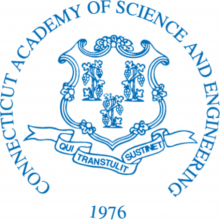Rocky Hill, CT — Connecticut’s most talented young scientists and engineers will be honored by the Connecticut Academy of Science and Engineering (CASE) at its 40th Annual Meeting and Awards Dinner on May 19, 2015 at the Crowne Plaza Hotel in Cromwell. Winners of this year’s Connecticut Science & Engineering Fair, Connecticut Junior Science and Humanities Symposium, and Connecticut Invention Convention will be recognized during the evening ceremonies.
The H. Joseph Gerber Medal of Excellence, established by CASE and presented in partnership with the Connecticut Center for Advanced Technology, will be awarded to the top winners of the Connecticut Science & Engineering Fair. The medal was created to recognize and honor H. Joseph Gerber’s (1924-1996) technical leadership in inventing, developing and commercializing manufacturing automation systems for a wide variety of industries, making those industries more efficient and cost-effective in a worldwide competitive environment.
This year’s keynote address will be a conversation with CASE Member Dr. Edison T. Liu, President & CEO of the Jackson Laboratory, hosted by Hartford Courant Columnist Dan Haar.
Student winners to be honored are:
The 2015 H. Joseph Gerber Medal of Excellence:
Olivia Hallisey, Greenwich High School, Greenwich, CT
2015 Connecticut Science & Engineering Fair – 1st Place, Life Sciences-Senior Division
Project: Temperature-Independent, Portable, And Rapid Field Detection Of Ebola Via A Silk-Derived Lateral-Flow System
Ethan Novek, Greenwich High School, Greenwich, CT
2015 Connecticut Science & Engineering Fair – 1st Place, Physical Sciences-Senior Division
Project: Low Grade Waste Heat Recovery And Carbon Sequestration Using An Innovative Reverse Electrodialysis (RED) And Pressure Retarded Osmosis (PRO) System
Eunsun Hong, Bridgeport Regional Aquaculture Science & Technology Education Center, Bridgeport, CT
2015 Connecticut Science & Engineering Fair – Urban School Challenge High School Winner
Project: Development Of Non-toxic Photostabilized Phycoerythrin For Application In Dye Sensitized Solar Cells
2015 Urban School Challenge Middle School Winner, Connecticut Science & Engineering Fair
Christopher Hwang, Westside Middle School Academy, Danbury, CT
Project: UV-C Lighting As A Supplemental Method Of Preservation In Refrigerators To Reduce Energy Consumption
2015 Connecticut Junior Science and Humanities Symposium
1st Place: Paul Han, Glastonbury High School, Glastonbury, CT
Project: Evaluation Of Several Resonant Power Electronic Converters In Capacitively Coupled Wireless Energy Transmitters
2nd Place: Ethan Novek, Greenwich High School, Greenwich, CT
Project: Low Grade Waste Heat Recovery And Carbon Sequestration Using An Innovative Reverse Electrodialysis (RED) And Pressure Retarded Osmosis (PRO) System
3rd Place: Anubhuti Mathur, Glastonbury High School, Glastonbury, CT
Project: Preparation And Comparison Of EGCG-Loaded PLGA And Cellulose Acetate Microparticles For Osteoarthritis Treatment
4th Place: Aakshi Agarwal, Hamden High School, Hamden, CT
Project: ACVR1/ALK2 Inhibitors As A Cure For Fibrodysplasia Ossificans Progressiva
5th Place: Nicolas Santandrea, Bridgeport Regional Aquaculture Science & Technology Education Center, Bridgeport, CT
Project: Biochar Electrodes Incorporated With Cuprous Oxide Substrates To Optimize Solar Cells’ Efficiency
2015 Connecticut Invention Convention
Avon — Talcott Mountain Academy of Science, Mathematics and Technology: Zachary Dornfeld and Nabeel Kemal
Bloomfield — CREC Academy of Aerospace & Engineering Middle School: Cristian Rodriguez
Bloomfield — CREC Metropolitan Learning Center for Global & International Studies: Angelique Ayala
Cromwell — Cromwell Middle School: Devon Schneider
East Granby — East Granby Middle School: Samantha Borsari
Farmington — Irving A. Robbins Middle School: Sai Chinta
Newtown — Newtown Middle School: Bryan Ingwersen
Southington — Joseph A. DePaolo Middle School: Lucca Riccio
Fishers Island, NY — Fishers Island School: Betsy Conger and Margot Hutchins
Torrington — Torrington Middle School: Logan Bermas, Chelsey Bournique and Kaitlyn Perbeck
Westbrook — Westbrook Middle School: Cristopher Guzman
Twenty-three newly elected members of the Academy will also be recognized during the evening.
The Connecticut Academy of Science and Engineering was chartered by the General Assembly in 1976 to provide expert guidance on science and technology to the people and to the state of Connecticut, and to promote the application of science and technology to human welfare and economic well being. For more information about the Academy, please see www.ctcase.org.
News Release
April 28, 2025

